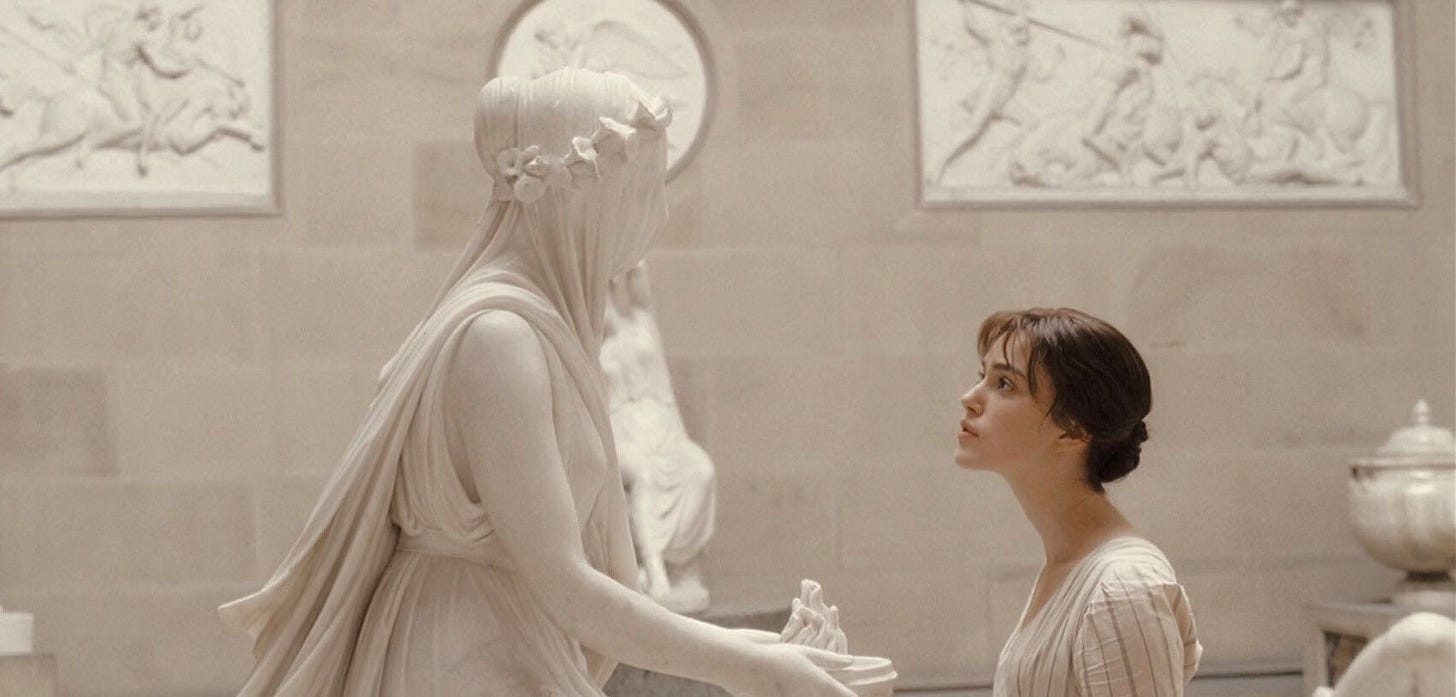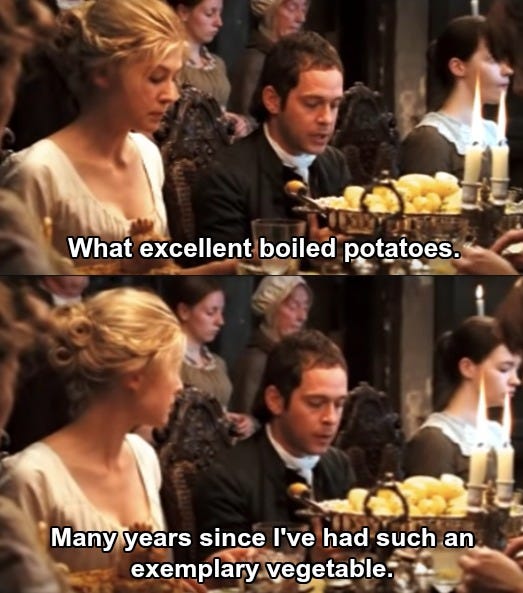#7: An exemplary vegetable
Good evening all,
I’m coming to you from my sofa, nestled in multiple blankets, clutching mugs of Earl Grey and handfuls of chocolate buttons, taking a break from watching the 2005 Joe Wright masterpiece that is Pride & Prejudice, on loop.
I couldn’t tell you how many times I have watched this film though I’d estimate its probably one of the few films I’ve seen enough times that it’s in the double digits. My current rate of viewing is at least a couple of times a year, and currently, twice, just this afternoon. Unusually, instead of getting bored, the space it holds in my heart seems to get bigger every time I watch it.
The story of my love affair with Jane Austen, the Bennets, Longbourn and Pemberley is a classic one shared by many. Pride & Prejudice is my mums favourite book and now, is also mine. A book and a film I once thought were pretty good, now regularly amaze me at how perfectly formed they actually are. Reading the book, I’m overwhelmed with envy that Jane should be able to weave together plot and characters so faultlessly in a way most of us could and will never be able to.
After years debating with my mum (as all Austen fan’s do), whether the BBC 1995 adaptation or Joe Wright’s 2005 feature is superior, I now find myself solidly in the 2005 camp. Sticklers for precise, accurate simple page-to-screen translation of the book rail against the cuts, the liberties taken with the production design, the more abstract moments but for me the way it translates the emotions the book evokes is second to none.
Watching this afternoon I found myself amazed by the fact that not a single subtle movement is missed. Though much of the dialogue from the book may have been cut for timing, the heart of this story is told through looks and glances. Roman Osin’s camera doesn’t miss a single smirk, eyebrow raise, twitch, hand flex… I found myself time and time again, watching the background characters. The shots are fluid, the camera floating effortlessly around the action and the hustle and bustle of characters flowing in and out of frame, making room for those who might not otherwise have been given any screen time in a scene to react to the action. Behind the epic story of Lizzie and Darcy, Joe Wright gives every character depth beyond what would seem doable in a feature-length. Mr Collins’ desperation to do the right thing but failing by simply trying too hard, Mary’s unspoken wish that Collins had chosen her instead, Mrs Bennet’s fierce love for all her daughters, Bingley’s social anxiety, Charlotte waiting and planning in the wings.
My favourite film moments are the ones that say so much without ever saying anything at all and the more I watch Pride & Prejudice, the more I appreciate the moments without words. It’s a symptom of period dramas that the romantic and sexual tension is created through how much is repressed and this film is no different. The choice to avoid dialogue in certain moments requires incredible talent from actors and this film does not lack in that. The hand that appears from nowhere to help Lizzie into the carriage; the painful moment of silence in the rain after the car crash of a proposal, where their eyes flicker briefly from eyes to lips and back again; the scene in the sculpture gallery, all soundtracked by what is no doubt one of the most gorgeous scores ever. If you’ve read the book (and/or studied it for an exam) there are certain lines burned into your brain. I realised as I watched that I knew what lines from the book were being played out on screen, with no words spoken, and yet absolutely no meaning was lost.
Though this adaptation is usually regarded as the more impressionistic, abstract one, I think, on the contrary, there’s an attention to detail in the film, that instead of making it overly perfect, creates something messy and real. For all the talk of naturalism, film as an art form often does a very poor job of making something feel tangible and real. Everything is so staged and blocked, restricted by the ability to move a camera or not reveal that a wall is false. The level of care taken over so much of the ability to work around the people we are watching, the freedom to improvise, the use of real light and real locations all help with the feeling of something being real. But what truly captures me when watching it is that the characters feel so real. In a family with five young daughters, someone is always talking over someone else, there’s always an animal or a servant coming or going, people are always smirking in the background at each other.
You can, as I have done, watch the film a dozen times and each time, watch something different, look at a different corner, spot a different reaction, hear a different line. And yet every time, still be caught up in the same story, still on the edge of your seat, waiting to see how it will play out.
So I guess if there’s any point to this newsletter it’s so that I can wax lyrical to people about this film because I adore it and watching it is very much my happy place. And I think everyone else should watch it too.
It might seem like an odd choice to spend your day watching a film you’ve seen plenty of times before, on repeat, and I’ll grant you, it’s a rare film that merits that, but this one does.
G x







